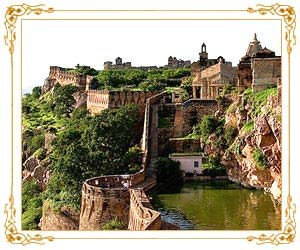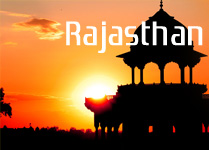 The Chittorgarh Fort has witnessed three bloody
sieges and 'jauhars' (a Rajput tradition in which royal maidens and
ladies immolate themselves in the fire to save their honor from the
cruel hands of the enemy, when there is no chance of defeating the
enemy). The walls and the atmosphere is still haunted with the gloom of
despair, valiant pride of the Rajput queens and ladies and sheer zeal
and bravery of their men who refused to cow down before the enemy. The
Rajput style of architecture is clearly visible in the fort, which is
said to be the Gahlot and Sisodia ruler of Mewar from the 8th to the
16th century. Named after Chittrangad Mauraya, the magnificent fort
rises 150 m above the surrounding region and runs to an approximate
length of 3 km covering an area of 60 acres and peripheral length of 13
km.
The Chittorgarh Fort has witnessed three bloody
sieges and 'jauhars' (a Rajput tradition in which royal maidens and
ladies immolate themselves in the fire to save their honor from the
cruel hands of the enemy, when there is no chance of defeating the
enemy). The walls and the atmosphere is still haunted with the gloom of
despair, valiant pride of the Rajput queens and ladies and sheer zeal
and bravery of their men who refused to cow down before the enemy. The
Rajput style of architecture is clearly visible in the fort, which is
said to be the Gahlot and Sisodia ruler of Mewar from the 8th to the
16th century. Named after Chittrangad Mauraya, the magnificent fort
rises 150 m above the surrounding region and runs to an approximate
length of 3 km covering an area of 60 acres and peripheral length of 13
km.The legend says that when the talks of Rani Padmini's beauty reched the years of Sultan Alauddin Khilji, the powerful ruler of Delhi, he requested her husband, Rana Rattan Singh, for a glimpse of the queen. Though, it went against the honor code of Rajputs, yet he was allowed to get a glimpse of the queen through the reflection of the queen in a water tank that overlooked the palace. Alauddin, then, had the audacity to attack Chittor to gain her possession. He won the war but lost Rani Padmini who committed 'jauhar' to save her honor.
The entrance of the Chittorgarh has seven massive gates, the two towers known as the 'Kirti Stambh' (Tower of Fame) and the 'Vijay Stambh' (Tower of Victory) along with several temples, reservoirs, and palaces dating between the 9th and 17th centuries.















